
My “office” this morning is the second floor of the Panera Bread restaurant, the obligatory wife sleeping in the chair nearby.
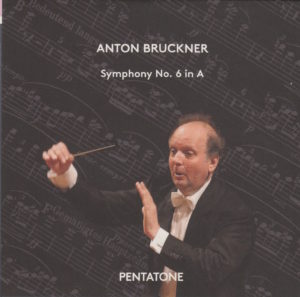 As she snores, I am listening to Anton Bruckner’s Symphony No. 6 in A Major (WAB 106), interpreted by Polish-born German conductor Marek Janowski (1939-).
As she snores, I am listening to Anton Bruckner’s Symphony No. 6 in A Major (WAB 106), interpreted by Polish-born German conductor Marek Janowski (1939-).
Maestro Janowski’s orchestra is Orchestre de la Suisse Romande.
The following bears repeating since it plays a role in the experience of listening to this morning’s symphony: the CD box set itself.
The Pentatone label is carving out a niche for itself as the high-end source for audiophiles of Classical music. Everything about this Janowski box set – like the Georg Tintner box set released by Naxos I reviewed in my 144 Days site – screams high quality. In fact, if I was going to release a cycle of a conductor’s symphonies, and I wanted to do it right, I’d do it this way (or the Naxos way – but the sound is better on the Pentatone label).
The Pentatone box is made of heavy cardboard with a top that slides off, just like the Tintner box from Naxos.
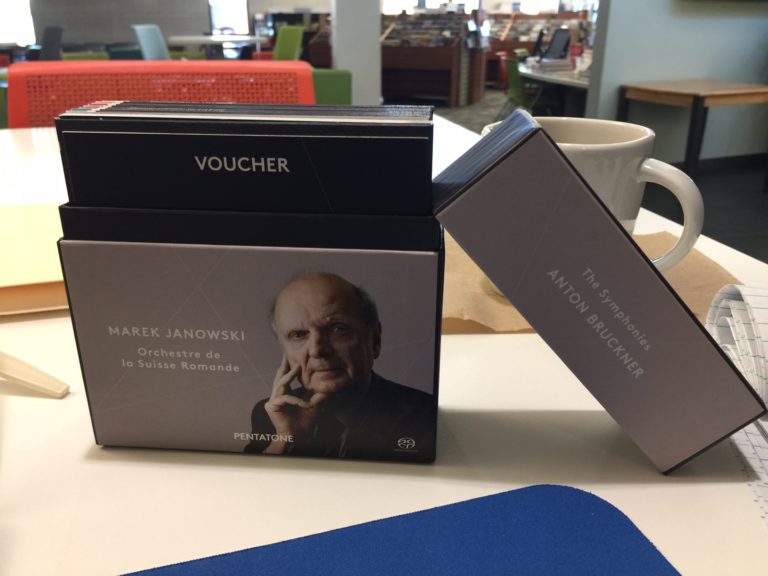
Inside is a treasure trove of CDs, a massive booklet of notes, and even a voucher for a free album download. (Which I haven’t taken advantage of yet. But I will.)
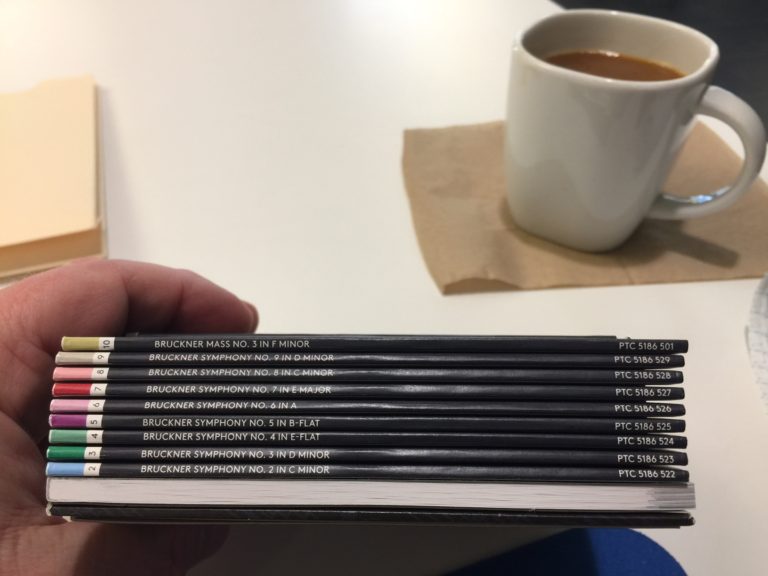
I’m tellin’ ya, this is a keepsake box, the sonic material given the treatment it deserves.
Just FYI.
If you want to know what I thought of Maestro Janowski’s interpretations prior to this day, check out Day 4, Symphony No. 1.
And Day 9, Symphony No. 2
And Day 15, Symphony No. 3.
And Day 22, Symphony No. 4.
And Day 30, Symphony No. 5.
Here are the objective aspects of today’s recording:
 Bruckner’s Symphony No. 5 in B Flat Major (WAB 105), nicknamed “Pizzicato Symphony” or “Tragic,” composed 1879–1881
Bruckner’s Symphony No. 5 in B Flat Major (WAB 105), nicknamed “Pizzicato Symphony” or “Tragic,” composed 1879–1881
Marek Janowski conducts
Janowski used the “Nowak Edition,” according to the back of the CD sleeve
Orchestre de la Suisse Romande plays
The symphony clocks in at 58:35
This was recorded at Victoria Hall, Geneva, Switzerland, in July of 2009
Janowski was 70 when he conducted it
Bruckner was 57 when he finished composing it (the first time)
This recording was released on the Pentatone label
Bruckner wrote his symphonies in four movements. The time breakdown of this one (Symphony No. 6 in A Major), from this particular conductor (Janowski) and this particular orchestra (Orchestre de la Suisse Romande) is as follows:
I: Majestoso…………………………………………………………………………………………………………17:56
II: Adagio. Sehr feierlich (Very solemnly)……………………………………………………………17:38
III: Scherzo. Nicht schnell (Not fast) — Trio. Langsam (Slowly)…………………………..8:52
IV: Finale. Bewegt, doch nicht zu schnell (With motion, but not too fast)………..12:54
Total Time: 58:35
Here’s a quote from the superb CD booklet written by Franz Steiger:
Bruckner wrote his Symphony No. 6 between September 1879 and September 1881. He himself never heard his sixth performed in a public concert, but only as part of a play-through rehearsal – but apparently he was so pleased with the results of his work that he made no further alterations. The composer described the sixth as his “boldest” symphony – and, indeed, it sounds modern, innovatory, perhaps even avant-garde.
Okay. Now, here are the subjective aspects of today’s recording:
My Rating:
Recording quality: 5
Overall musicianship: 5
CD liner notes: 5 (big, thick, substantive booklet with insightful essays about the symphonies, the orchestra, and the conductor translated into English, German, and French)
How does this make me feel: 5
Before I mention what I liked about today’s performance, I have to mention again what I noticed last time that I dislike about the Janowski box set.
When I wanted to find out the details of the performance today – like, when and where it was recorded – I couldn’t readily and easily determine that.
That’s because neither the back of the CD sleeve (below) nor the front (above left)…
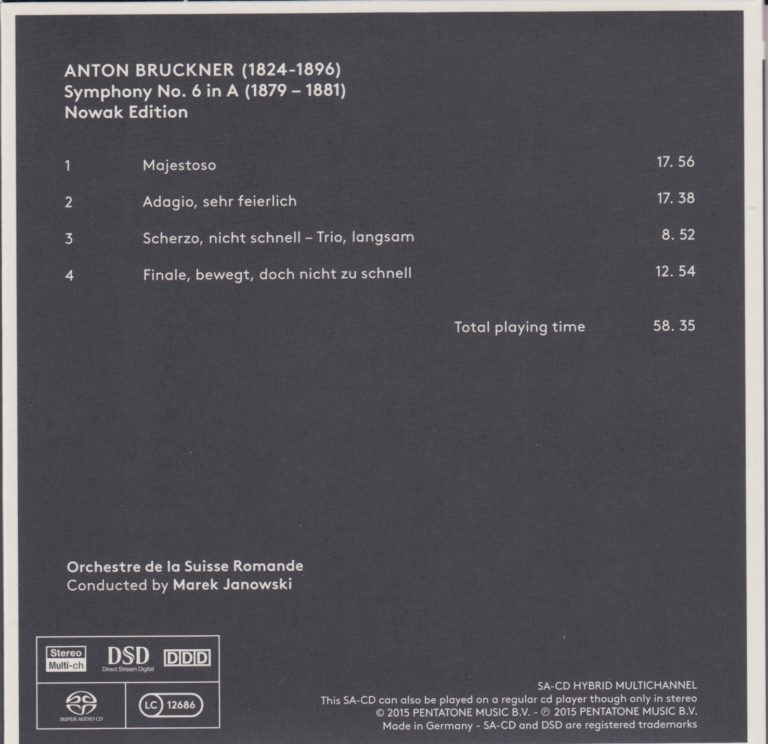
…tells me which CD this is.
Is it CD #4? CD #6? CD #5? CD #7?
The reason why that’s important is because in the Production Credits of the booklet it don’t tell me which symphony corresponds to which CD number.
Note:
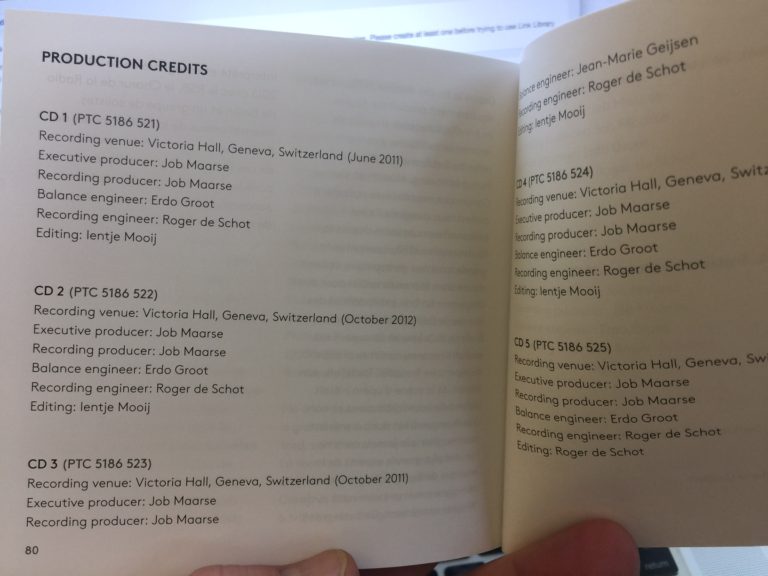
And this:
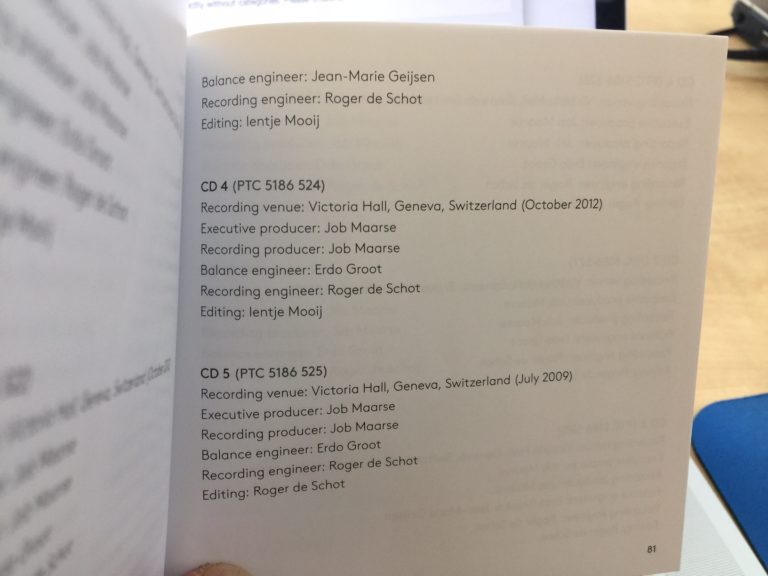
Okay, from all of that, can you tell me which CD Symphony No. 6 is on?
No. You can’t.
So there’s no way to tell to what the production credits – as meticulous as they are – refer.
The reason why that’s not as obvious as you might think is because in many of these CD box sets, the symphony numbers didn’t match the CD numbers. In other words, Symphony No. 4 wasn’t always on CD 4. This was especially true with the Karajan box set I reviewed in the first leg of my Bruckner journey (144 Days With Bruckner and Me). The number of the symphony and the number of the CD rarely matched in that box set.
Why?
Two reasons, at least:
1. Sometimes, the CDs start the number with Symphony No. 0. So, CD 1 is Symphony No 0.
2. Sometimes, a symphony is split across two CDs – especially with Loren Maazel, Simone Young, or – as I discovered in this leg of my Bruckner journey – Celibidache. A standard CD holds 79 minutes of music. If a conductor’s interpretation goes beyond 79 minutes, then it takes two CDs to hold it. That means Symphony No. 5 will be on, say, CD #5 and CD #6.
So, this morning, as I’m trying to figure out the production information, I remembered that I took a picture of the inside of the box. The number of the CD is on the spine of each sleeve! From that, I was able to see that CD #6 is Symphony No. 6.
But I shouldn’t have had to go through all the trouble.
The folks at Pentatone did virtually everything right. But they forgot something as simple as enabling customers to see which CD they had in their hands. (I even looked at iTunes, which often lists the number of the CD it is – for example CD 6 of 12 – in the information section. This time, it just said CD 1 of 1. So I couldn’t even tell from iTunes what CD I had ripped.)
Two easy fixes for that:
1. List the symphony in the Production Credits under each CD number.
2. Print the CD number on the back of the CD sleeve.
Okay. I won’t mention that again. But it bore repeating because I had the same problem tonight as I did the last time I listened to a Janowski performance.
As to the music on today’s CD…
I was drawn in from the first notes of the Majestoso. The violins playing the staccato rhythm while the sonorous cellos enter with their ominous low notes…then the horns. It’s all very clear and, well, magical. I especially enjoyed the last 3-4 minutes. Stirring stuff. (By the way, the crystal-clear way this is recorded makes one feel the cellos at the beginning. They leap out of the speakers more clearly than in any other recording I have of Bruckner’s Sixth.)
I was so intrigued by how close to the Lawrence of Arabia theme song the Majestoso is that I watched the Oscar-winning movie later today. I’m watching it now, in fact.
It’s hard for me not to like Bruckner’s Sixth.
Every movement has something to offer – even the Adagio. In Janowski’s hands it’s truly majestic and beautiful.
Then, of course, there’s the Scherzo – my favorite of Bruckner’s movements. I love Janowski’s interpretation. It’s brash and energetic. Muscular.
I have to say, this entire performance rates a very big…
“Huzzah!”

Hi!
I haven’t heard the Janowski Bruckner recordings but I will! I have friends recommending it too.
And …
Have a look at the back of the CD-sleeves (third picture from the top of this page), you will find the CD-numbers there.
/Niklas
Hi Niklas,
I think you’ll like the Janowski box – even if just for the quality of the box itself. The recording is one of the best I’ve ever heard. And the box is a work of art, too.
I know the CD number is on the spine of the CD sleeves. But if all I have is a scan of the back cover, or the information ripped into iTunes, there’s no way for me to know which CD I’m listening to and which information in the booklet my CD corresponds to. The booklet doesn’t list the symphony. And neither iTunes nor the back of the CD sleeve lists the CD number. So matching up that information isn’t as easy as it should be.
In other words, unless you’re carrying around that box of CDs so that you can see the spine of the CDs, you won’t know which CD you’re listening to.
But that’s just me.
Not everybody needs to know the CD #, I guess.
Anyway, I think you’ll enjoy the Janowski box. I’m just amazed Pentatone cared enough about the music to present it so well. That, in itself, justifies the purchase. I want to support a label like that.
Bill